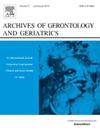Determinant of functional independence in older patients with heart failure: physical function vs. muscle mass
IF 3.5
3区 医学
Q2 GERIATRICS & GERONTOLOGY
引用次数: 0
Abstract
Aim
While sarcopenia affects functional independence in older patients with heart failure (HF), the differential impact of its components—including muscle mass (MM), muscle strength (MS), and physical function (PF)—remain underexplored. We investigated these components’ independent and synergistic associations with functional independence in older patients with HF, including sex-specific differences.
Methods
We studied 587 older patients with HF (299 women; mean age, 79±7 years). MM, MS, and PF were assessed using dual-energy X-ray absorptiometry, handgrip strength, and physical performance tests (gait speed, five-times sit-to-stand test [FTSS], short physical performance battery [SPPB]), respectively. Cutoffs for each component followed the Asian Working Group for Sarcopenia 2019 criteria. Functional independence was assessed using the Barthel Index (BI).
Results
Sarcopenia was associated with lower BI scores. Poor PF independently predicted reduced BI scores (slow gait speed: 8.4 points; prolonged FTSS: 10.9 points; low SPPB: 14.8 points; all p < 0.001), whereas low MM and weak MS did not. Low MM amplified the negative impact of poor PF on BI scores consistently across sexes. Machine-learning analysis revealed MM status-specific predictors of PF: clinical factors (female sex, HF symptoms) and comorbidities predicted poor PF in patients with normal MM; renin-angiotensin system inhibition, and cardiomyopathy were associated with preserved PF in patients with low MM.
Conclusions
In older patients with HF, sarcopenia is closely and negatively associated with BI score primarily through poor PF; MM potentially modifies this relationship independent of sex. MM status-specific factors associated with PF suggest the importance of phenotype-specific approaches in facilitating functional independence.

老年心力衰竭患者功能独立性的决定因素:身体功能与肌肉质量
虽然骨骼肌减少症会影响老年心力衰竭(HF)患者的功能独立性,但其组成部分(包括肌肉质量(MM)、肌肉力量(MS)和身体功能(PF))的差异影响仍未得到充分研究。我们研究了这些成分与老年心衰患者功能独立性的独立和协同关联,包括性别特异性差异。方法我们研究了587例老年HF患者(299例女性;平均年龄79±7岁)。MM、MS和PF分别采用双能x线吸收仪、握力和物理性能测试(步态速度、五次坐立测试[FTSS]、短物理性能电池[SPPB])进行评估。每个成分的截止值都遵循亚洲肌少症工作组2019年的标准。采用Barthel指数(BI)评价功能独立性。结果肌少症与较低的BI评分相关。PF差独立预测BI评分降低(慢步速度:8.4分;长期金融稳定指数:10.9点;低SPPB: 14.8分;所有p <;0.001),而低MM和弱MS则没有。低MM放大了低PF对BI得分的负面影响,这在性别上是一致的。机器学习分析显示MM状态特异性预测因子:临床因素(女性、HF症状)和合并症预测正常MM患者PF不良;结论在老年HF患者中,肌少症与BI评分呈负相关,主要通过PF差与BI评分呈负相关;MM可能会改变这种独立于性别的关系。与PF相关的MM状态特异性因素表明,表型特异性方法在促进功能独立性方面的重要性。
本文章由计算机程序翻译,如有差异,请以英文原文为准。
求助全文
约1分钟内获得全文
求助全文
来源期刊
CiteScore
7.30
自引率
5.00%
发文量
198
审稿时长
16 days
期刊介绍:
Archives of Gerontology and Geriatrics provides a medium for the publication of papers from the fields of experimental gerontology and clinical and social geriatrics. The principal aim of the journal is to facilitate the exchange of information between specialists in these three fields of gerontological research. Experimental papers dealing with the basic mechanisms of aging at molecular, cellular, tissue or organ levels will be published.
Clinical papers will be accepted if they provide sufficiently new information or are of fundamental importance for the knowledge of human aging. Purely descriptive clinical papers will be accepted only if the results permit further interpretation. Papers dealing with anti-aging pharmacological preparations in humans are welcome. Papers on the social aspects of geriatrics will be accepted if they are of general interest regarding the epidemiology of aging and the efficiency and working methods of the social organizations for the health care of the elderly.

 求助内容:
求助内容: 应助结果提醒方式:
应助结果提醒方式:


